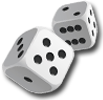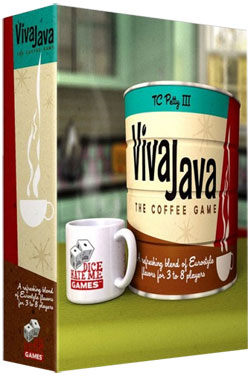



play board games
Board game reviews, strategy tips & session reports
VivaJava: The Coffee Game Review
 Stats:
Stats:
No. of players: 3-8
Amount of time to play: 90 min
Age requirements: 13+
Set-up time: 5 minutes
VivaJava is a semi-cooperative game about making coffee. You must research and create the best blends to get the most performance points and win.
VivaJava Rules Description:
You start VivaJava with your research board, roaster and a couple beans. Each turn, starting with the player in last place to the player in first, you put your field researcher on an unoccupied map space. Map spaces get you a bean which is added to your roaster and a country action. The country actions are a random bonus or penalty for going there to get your beans. The map is divided into three sections and this determines whose team you are on for this turn.
Once everyone has taken their beans and country actions each team must determine if they’ll blend or research. Majority vote wins and ties result in the group researching. No matter which option is picked, the group must all do that action.
Researching allows you to add research points to your research board. You can research five different areas that will help you get more beans, invest in another team’s blends, gain flavor cards or select the beans you really want when blending. The more research points you put into a track the better your benefit and the more bonus points you’ll score at the end of the game. Flavor cards get you bonus points and abilities and can only be gained from researching flavor. If you research for your turn you can also convert performance points into research points on a one to one basis.
If a team decides to blend then they must fill the blending slate that was above the country they got their beans from. Usually this means drawing a total of five beans from your roaster, but there are times a bean is already provided by the slate. When you blend each player randomly pulls a bean from their roaster and adds it to the blending slate. Each player on the team must put at least one bean onto the blending slate. The team decides the order for this but once you decide to stop you cannot add more beans later.
After each team blends you add their blends to the best-seller list. The more popular your blend the more performance points you’ll score. You determine the popularity of a blend with a poker-like scale. Five beans of one kind ranks the highest while one pair of matched beans ranks lowest. There is also a ranking for the six colors of the beans that is used to break ties when two teams have blended the same set. As a bonus you also gain one research point for successfully brewing a blend that makes it on the best-seller list.
In the final phase of each round you score performance points based on any blends you currently have on the best-seller list. Then all blends on the list degrade. You remove the least important bean from the slate and than adjust the list before starting the next turn. This is how new blends can knock old ones of the list. There is one special blend, the rainbow blend that does not degrade. It consists of five different beans and is ranks in the middle for popularity. It remains on the best-seller list until another rainbow blend is added or until it is knocked off if there are a lot of more popular blends.
The game ends when there are no more blend slates to add above the world map, if someone researches four of their research tracks to the end or once someone reaches 21 performance points. In turn order you add performance points for researching levels and any end-track research bonuses. The player with the most performance points wins.
Quick Review of VivaJava:
I first played VivaJava at the WBC in 2011. I enjoyed it then and still think it is a lot of fun. I have never played with less than five and think the game is best with five to eight players. The way it blends (pun intended) many common mechanics into a unique game experience is great.
The game looks awesome. The components are high quality, the rules are easy to read and everything is well-designed. The only complaint I have about the components is the color of the red beans and brown beans are a bit too close. Maybe it is the lighting in my house but players were had a hard time telling the colors apart.
I really like the number of players that can play this game and how well it flows even when you play with eight. And since each round there is a maximum of three teams there is not a ton of downtime.
I also think this semi-cooperative game is truly unique. The way your team changes each round and yet no one is really on your team, is cool and creates some tension.
There are also many variants in the rule and even an expansion included in the game (they call it an inspansion). This enhances its already high replay value.
The game is not perfect though. It can sometimes be hard to overtake the leader. Especially if you constantly end up on their team there is little you can do but keep pace with them. Maybe with more plays I’ll discover a way to catch the leader easier.
VivaJava is a very good game that is fun and can be played with a large group. It is truly unique and fills a niche in most every gamers collection. If you are looking for a medium-weight social game that handles a lot of players well, you should try or just buy VivaJava.
Score and synopsis: (Click here for an explanation of these review categories.)
Strategy 3 out of 6
Luck 3 out of 6
Player Interaction 5 out of 6
Replay Value 5 out of 6
Complexity 4 out of 6
Fun 5 out of 6
Overall 5 out of 6

Leave a Reply